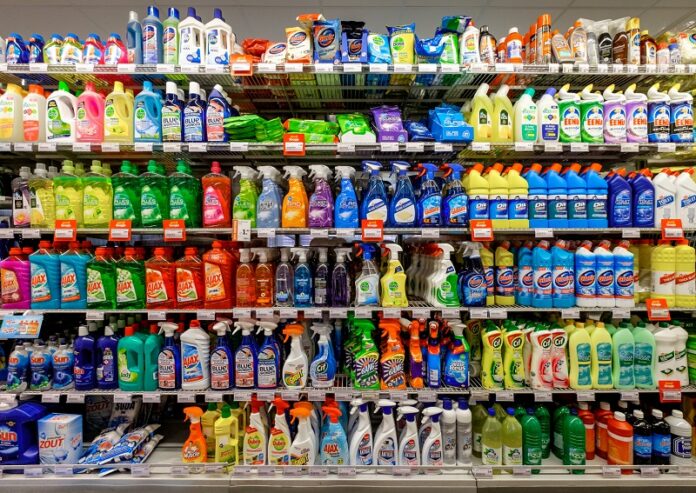A spotlessly clean house could indicate that the owners take the effort to keep their home clean and tidy daily. While this cleanliness trait is no doubt an admirable, and commendable quality, there could be a health downside to all this cleanliness, especially if they use many of the common cleaning products available in the market.
A new analytical study published in mid-September found that conventional cleaning products used to mop floors and scrub walls and counters may release hundreds of hazardous volatile organic compounds (VOCs) that could harm the health of people and pets in homes.
VOCs are organic chemical compounds that have a high vapor pressure at room temperature, which causes them to vaporize readily under normal temperature and pressure. They are responsible for the characteristic odors that arise from perfumes, deodorants, cleaning products, as well as from pollutants.
Volatile chemical compounds are used and produced in the manufacture of numerous products. They are also emitted by a wide array of household products, including paints, pesticides, building and furnishing material, glues and adhesives, as well as by many of the common cleaning products used regularly around the home.
VOCs in cleaning products affect the quality of air both indoors and outdoors. But they contaminate indoor air two to five times more than outdoor air, with some estimates putting it as high as 10 times that of outside air. In addition, the VOCs in some products continue to be emitted for days, weeks, or even months after their initial use.
A previous study had shown that more than 100 types of common consumer cleaning products contain at least one and often multiple VOCs and other chemicals that have been linked to multiple health conditions including pulmonary diseases, cancer and reproductive as well as developmental problems.
The potential health harms of VOCs are not limited to people inside their homes, it is also emitted in workplaces, and is most pronounced among workers in the cleaning industry. While people have the option to choose what cleaning products they use within their homes, cleaning workers compelled to work daily with harsh and hazardous chemical cleaners do not have that choice.
A study published in 2020 found that people working in the cleaning industry have a 50 percent higher risk of developing asthma and a 43 percent higher risk of chronic obstructive pulmonary disease. According to the study authors, their findings have implications not only for human health but also for environmental health, as several VOCs emitted by consumer products also cause outdoor air pollution. A previous study estimated that half the VOCs responsible for air pollution stem from consumer products.
The new analysis which tested 30 cleaning products,such as specific cleaners for floors, walls and glass, as well as multi-purpose cleaners, air fresheners, and disinfectants, including cleaning products labeled ‘green’ found significant VOCs in the products tested. The analysis showed a total of 530 unique VOCs in the 30 products tested. Of these, 193 VOCs were hazardous, meaning they have the potential to be harmful to health. The study also showed air fresheners to be the overall highest emitters of hazardous VOCs per product and per application.
On the positive side, researchers behind the new study found that cleaning products certified to be ‘green’ emitted fewer VOCs than conventional products — about half the number on average. They also found that the green products labeled as ‘fragrance free’ produced the fewest VOC emissions of all the products — nearly eight times less than conventional products.
The study also confirmed that the ‘green’ products they sampled not only released significantly fewer VOCs, but also lower amounts than their conventional counterparts. Even the highest emission among the green cleaners, methanol, is a less-potent hazard than some of the other chemicals emitted from the conventional products.
Unfortunately, apart from established certifications such as the ‘Safer Choice’ option certified by the United States’ Environmental Protection Agency (EPA), and similar official authentications in a few other countries, it can be very hard to verify claims of ‘green’ labeled products and to know if they are actually safer,
Products labeled ‘green’ emitted about half the number of VOCs and about eight times fewer VOC emissions than conventional products. Fragrance-free products produced about four times fewer emissions than even the products that were labeled to be only ‘green’. That pattern also held true for the number of VOCs considered hazardous in the products. The unscented ‘green’ products emitted just four chemicals classified as hazardous, on average, compared with about 15 in ‘green’ products with fragrance, and 22 in conventional products.
The study authors concluded that their study emphasizes choosing green or green and fragrance-free cleaning products could be the safer choice for consumers concerned about indoor air quality and potential health risks.
In most countries policies regarding use and manufacture of chemical products have failed to incentivize the production of safer, greener, chemical products and materials. There are very few countries that have rigorous requirements for companies to test chemicals, in particular cleaning and other chemical products used regularly in homes and industries, for human safety. As a result many product manufacturers continue to rely on inexpensive but harmful chemicals that work well and are inexpensive.
More expensive greener products cannot compete on an equal footing with inexpensive items. Only when more consumers become aware of the dangers of VOCs in the products they use on a daily basis will demand for greener safer products increase, and consequently drive policymakers to design and implement policies that require manufacturers to follow more stringent chemical safety standards, and incentivize the production of safer, greener household products.
Copyright: Project Syndicate
www.project-syndicate.org

















